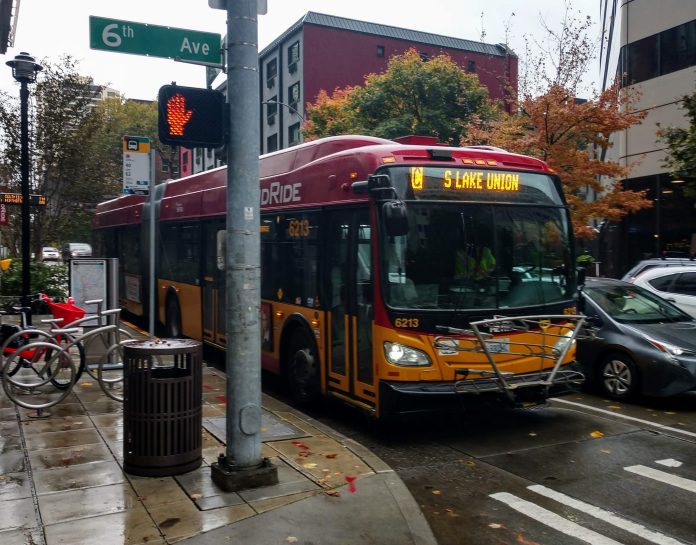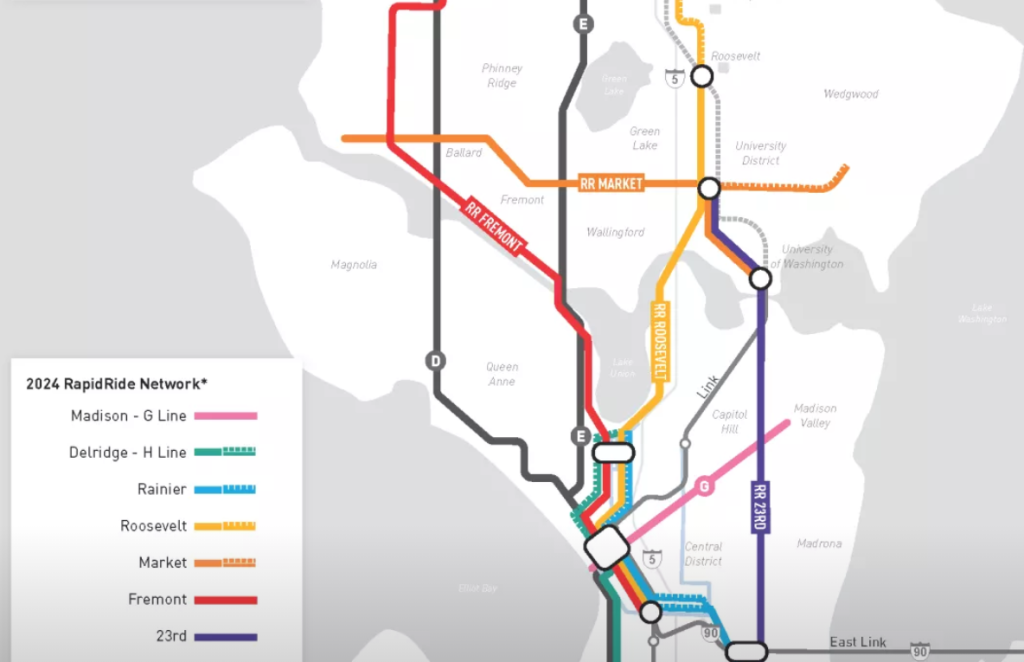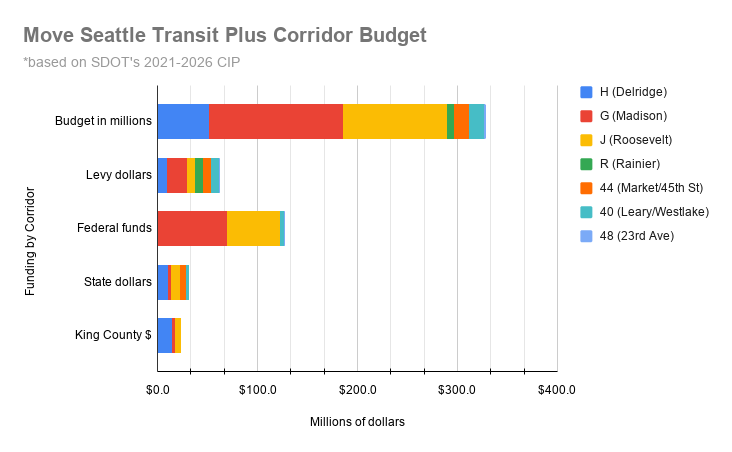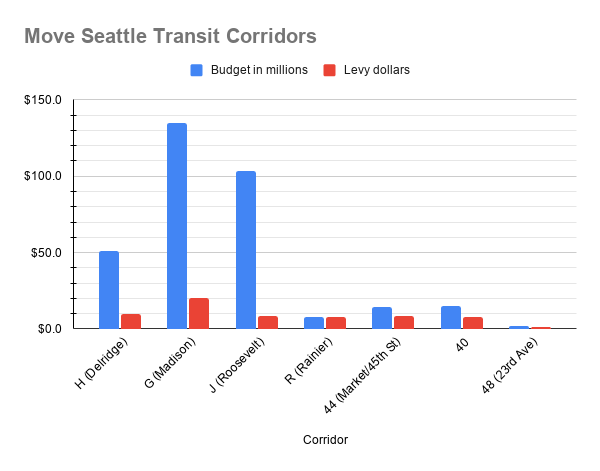
Back in 2018, we reported that Mayor Durkan’s “Move Seattle Reset” had cut Route 40, Route 44, and Route 48 from RapidRide plans, instead promising lesser improvements. This month, we learned that King County Metro and the Seattle Department of Transportation (SDOT) have also dropped the Rainier Avenue corridor from RapidRide plans, although some bus lanes in Hillman City and Rainier Beach have been installed to help speed Route 7 (map here).
That leaves just three of the original seven new RapidRide corridors in the program, and one of those is now in a shortened form.
In 2015, the Move Seattle Levy passed with 58.7% of the vote on the promise of a bevy of improvements including seven new RapidRide corridors on aggressive timelines and budgets. Five years later, none have yet been delivered–although two are nearing construction and the RapidRide H Line slated to open in late 2022.

RapidRide J: Still alive, just shorter
SDOT is now planning to terminate RapidRide J (which upgrades Route 70) at U District Station, scaling back initial plans to reach as far as Northgate Station and later revisions to end at Roosevelt Station. While rumors that RapidRide J Line was being shelved entirely are still false, leaving out the northern half of the corridor–which was named Roosevelt RapidRide after all–will likely disappoint some riders. Even with another mile trimmed from the route, SDOT projects that the RapidRide J Line will get robust ridership and secure $53 million in grant funding.
Metro is tabbing a 2022 opening for the RapidRide H Line in the Delridge corridor and the RapidRide G Line on Madison Street is now 2024 after numerous delays and snags–for example, while formerly planned as an electric trolleybus, the route is now using diesel hybrid buses due to difficulties procuring the proper vehicles with both side boarding.
Why the cuts?
So how did we go from seven promised RapidRide lines to two and a half? During the reset, Mayor Durkan argued that the initial Move Seattle promises under the Murray administration were too ambitious and stretched budgets too thin.
The latest round of cuts do not stem from less Move Seattle levy proceeds, which have actually exceeded projections slightly. Instead the $70 million hit to local matching funds have pushed the latest round of cuts. The real estate excise tax (REET) which had been counted on to top up transit project budgets instead is being set aside to back bonds to pay for West Seattle Bridge repairs. One year ago it would have been hard to imagine how a 36-year-old freeway bridge would fail and disrupt the transit budget, and yet that’s the world we live in.
The other big drag on RapidRide ambitions has been the Covid-triggered hit to finances at the County level. King County Metro’s budget, which depend on lagging sales tax revenue and fare revenue, took a big hit as fare collection was halted during the pandemic to lower the viral transmission risk to bus drivers. Fare collection resumed October 1st, but with ridership barely a third of normal levels, it’s unlikely to change the financial picture much in the near-term.
With fewer resources, SDOT and Metro focused attention on the three corridors that remain slated for RapidRide upgrades. The RapidRide G and J Lines alone consume 72% of the transit plus corridor budge, as they are two project slated for federal Small Starts grants. While not a recipient of federal grants, the RapidRide H Line consumes 15.6% of the total as the top recipient of King County dollars. The total is found using the updated SDOT Capital Investment Program 2021-2026 that was released along with the 2021 budget.

Route 48 shortchanged
That leaves the remaining four projects splitting just 12% of the budget. While Madison RapidRide did consume the most levy dollars of any project, most of the projects got a fairly similar sized piece of the pie, except for Route 48, which only has a two million dollar budget–less than half from the levy.

SDOT spokesperson Dawn Schellenberg said bus lanes and other reliability upgrades remain in the works, although the details remain fuzzy at this point.
“The Route 48 Transit-Plus Multimodal Corridor Project will include transit speed and reliability improvements, such as bus only or Business Access Transit (BAT) lanes, queue jumps, channelization and signal optimization for buses, and transit signal priority,” Schellenberg said. “Work may also include pedestrian-scale lighting, sidewalk and curb ramp upgrades, communication infrastructure, and other similar elements.”
Route 7 sidewalk upgrades jettisoned
The previous plan for Route 7 was for two stages of upgrades with bus lanes coming sooner as we at the Move All Seattle Sustainably (MASS) Coalition had pressed for. In the second phase, Route 7 would have officially become a RapidRide with red articulated buses and bus stop upgrades including off-board payment and improved shelters. Until the latest cut, the agencies had hoped that the RapidRide R Line would open in 2024, but that’s off the table for now.
Schellenberg said “significant revenue reductions related to Covid-19” pushed SDOT to cut $1 million from the approximately $9 million budget for the Route 7 Transit Plus project. “This means we’re focusing on the transit safety and access improvements and no longer have funding for sidewalk repair along Rainier Ave S,” she said. “However, if additional funding becomes available, we may be able to add sidewalk repair back to our list of improvements.”
Move Seattle Transit-Plus Corridors after 2020 Reset
| RapidRide Corridor | 1st Revision | 2018 Reset Date | 2020 Covid Reset | Budget in millions | Existing Route | 2016 Daily Ridership | Platform Hours (2016) |
|---|---|---|---|---|---|---|---|
| G (Madison) | 2021 | 2021 | 2024 | $134.7 | 12 | 3,300 | 84 |
| H (Delridge) | 2020 | 2021 | 2022 | $51.1 | 120 | 8,600 | 226 |
| R (Rainier) | 2021 | cut | ? | $7.5 | 7 | 10,800 | 255 |
| J (Roosevelt) | 2021 | 2024 | 2024 | $103.4 | 70 | 7,500 | 182 |
| Market/45th St | 2022 | cut | 2024 | $14.6 | 44 | 8,400 | 167 |
| Fremont | 2023 | cut | 2024 | $15.2 | 40 | 11,400 | 284 |
| E 23rd Ave | 2024 | cut | ? | $2.1 | 48 | 5,500 | 183 |
| Move Seattle Transit-Plus portfolio | $328.6 | 47,100 |
While Metro and SDOT have touted the respective equity lenses they use to make these decisions, it’s hard to square that with Route 7 and Route 48 slipping from RapidRide plans and getting upgrades downsized. Serving the Central District and the Rainier Valley means these routes are some of the most essential to Black and brown communities and low-income populations. Somehow projects that would compete for state and federal funding were not devised for these corridors.
SDOT had also cut one five-block bus lane under consideration just south of I-90.
“We had been studying adding a northbound BAT (Business Access and Transit) lane on Rainier Ave S between College and Grand streets that would have removed the center turn lane from that section and added new traffic signals at College and Grand,” Schellenberg said. “After considering the impacts to neighborhood access and other parts of Rainier, we decided to allow for continued analysis of transit priority treatments in this section in collaboration with King County Metro. We still plan to install a southbound BAT lane from S McClellan St to Martin Luther King Jr Blvd S.”
Along with new bus lanes already installed from S Kenny St to S Henderson St, this should at least shave a few minutes off Route 7’s transit times.
Routes 44 and 40 see some cuts
At the last project update, Route 44 had gotten some additional sections of bus lanes. It appears that’s still happening, but associated access and safety improvements may be on the chopping block.
“Given the significant revenue reductions due to COVID-19 identified earlier in the year, the Route 44 project team anticipated the need to reduce project budgets and developed a proposed package of improvements to advance into final design that reflects the current revised budget,” Schellenberg said. “While there could have been additional investments in access or safety improvements, the project is moving forward with a well-rounded package of transit speed and reliability, access to transit, and safety improvements.”
It’s a similar story for Route 40, which had promised as much in the way of bus lanes yet.
“The Route 40 project team is currently in the project development phase and recently completed a round of community outreach this summer,” Schellenberg said. “We will develop a recommended package of improvements for 30% design that reflects this reduced budget. We are also is seeking grant resources and evaluating partnership funding options with King County Metro.”
While there’s hope rebounding finances could put bigger improvements back on the table for Route 44 and 40, for now it’s looking more modest.
Spread too thin
So we’re left with a lopsided RapidRide program. The RapidRide H, G, and J Lines should be big upgrades when they open that really transform their respective corridors–even in their shortened forms. The rest of the pack isn’t looking to get the same level of investment. Part of the reason lies in the way federal and state funds are doled out. Neither invests as much as they should in transit and to jump through the hoops properly takes a delicate dance. It’s challenging to do for seven projects on overlapping timelines.
If every corridor managed to get a Small Start grant from the feds, each could have delivered on the hype from when they were first put on the ballot. Without help from outside sources, the Move Seattle budget was spread too thin to truly remake each corridor. Still, if the State, County, and Federal governments committed to transit in a bigger way than they do now, it could help get Metro’s ambitious RapidRide vision back on line.
Doug Trumm is publisher of The Urbanist. An Urbanist writer since 2015, he dreams of pedestrianizing streets, blanketing the city in bus lanes, and unleashing a mass timber building spree to end the affordable housing shortage and avert our coming climate catastrophe. He graduated from the Evans School of Public Policy and Governance at the University of Washington in 2019. He lives in East Fremont and loves to explore the city on his bike.


